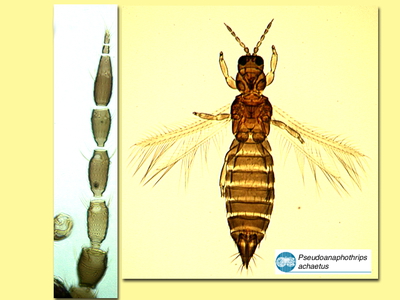Figures
Fig. 1 Antenna, head, thorax and abdomen
Fig. 2 Head (dorsal)
Fig. 3 Pronotum
Fig. 4 Meso- and metanotum
Fig. 5 Fore and hind wing
Fig. 6 Tergite VIII
Species
Pseudanaphothrips achaetus Bagnall
Biology
Although found in a wide range of flowers, both native and introduced, the range of host plants on which this species can breed has yet to be established.
Distribution
An Australian species that is apparently widespread and common throughout this continent, and is also established in New Zealand.
Recognition
Small brown thrips with shaded forewings. Antennae 8-segmented, sense cone on III & IV forked. Head with one pair of setae in front of fore ocellus, and one pair arising between hind ocelli. Pronotum with no long setae. Metanotum with sculpture lines on posterior half making a lens-like shape; median setae at anterior margin. Forewing first and second veins with complete row of setae. Tergites VII & VIII with microtrichia on several lines of sculpture, but no regular ctenidia; VIII posteromarginal comb with median teeth long and pointing mesad. Sternites with no discal setae.
Related species
A total of 12 species are placed in this genus. Most of these cannot be distinguished from each other satisfactorily, although they all differ from P. achaetus in having two pairs of long posteroangular setae on the pronotum.







